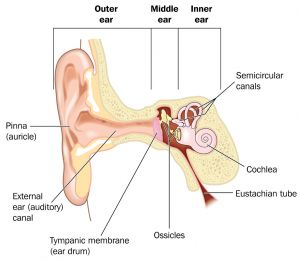“Mommy, my ear hurts.” It’s a sentence no parent wants to hear, yet most of us will. Year after year, ear infections rank among the top reasons parents take their kids to the pediatrician.

an ear infection.
There are different types of ear infections (such as the outer ear infection known as swimmer’s ear), and they all can cause temporary hearing loss. Yet, in children, it’s middle ear infections that are most associated with temporary hearing loss.
Also called acute otitis media, middle ear infections result in ear pain and inflammation. During or after the initial infection, fluid can build up in the air-filled space behind the eardrum, which is known as otitis media with effusion.
This build-up can reduce movement of the eardrum and middle ear bones, leading to trouble hearing. This can be alarming, but there is good news: If treated properly, the infection will clear, the ear pain will go away, and your child’s hearing ability will return to normal. Still, it’s important to learn the causes, symptoms and risk factors so you know when to seek medical help for your child.
Table of Contents
Causes of middle ear infections
In short, middle ear infections almost always develop during or after upper respiratory infections, such as the common cold. The infection causes inflammation and swelling in the back of the throat, including the anatomical part known as the the Eustachian tube. This tube connects the throat to the middle ear, and when it’s swollen, it can no longer equalize the pressure in the middle ear space.

fluid can accumulate—causing pain,
pressure and infection.
This pressure builds up in the tiny middle ear space and normal secretions can’t drain away as they normally would. The negative pressure and excess fluid can cause ear pain, pressure, dizziness and temporary hearing loss.
Why are children so prone to ear infections?
Middle ear infections can happen to anyone with a cold. However, younger children are far more prone to middle ear infections for two reasons. First, their immune systems are less developed, so it’s harder to fight off respiratory infections. Second, their Eustachian tubes are more horizontal, making it harder for fluid to drain.
Another risk factor for middle ear infection is a chronic infection of the adenoids or tonsils. These glands are close to the Eustachian tube, so viral or bacterial invaders can easily spread to the middle ear. In those cases, an ear-throat-nose specialist, known as an otolaryngologist, may recommend surgical removal of those glands—known as a tonsillectomy or adenoidectomy—to prevent the spread of infections in the future. Once the surgical areas have healed and the middle ear space is ventilated, middle ear infections will likely get better.
Symptoms of middle ear infections
For babies and toddlers, it can be difficult to recognize symptoms for little ones who cannot verbally express the ear pain or irritation they might be experiencing. If you’re concerned a child that you take care of could have a middle ear infection, look for these tell-tale signs:
- Fever
- Constant or frequent scratching or pulling at the ears (indicating pain or discomfort)
- Slowed response to voices and other sounds (indicating trouble hearing)
- Irritability
- Secretions from the ear
For older children, adolescents and adults, these symptoms are possible:
- A constant earache
- A feeling of pressure in the ears
- Difficulty understanding speech
- Feelings of dizziness or imbalance
- Vomiting or general nausea
- Rarely, a feeling of “double hearing”
If you or your child has any of the symptoms above, call your pediatrician, family doctor or otolaryngologist. It is important to act quickly because a middle ear infection can easily be treated and the ear pain alleviated. Here’s what to do if it’s the weekend or a holiday.
For children with autism, ear infection diagnosis may be delayed, due to communication difficulties. However, they are not more prone to infections than other children. More: Autism, auditory processing disorder and your child’s hearing health.
The link to hearing loss
Middle ear infections can affect your child’s hearing. This can be unsettling, but it’s almost always temporary and doesn’t result in any permanent hearing loss. Still, any hearing loss should be evaluated by a healthcare professional.
Addressing hearing loss is important because infants and toddlers who suffer from chronic ear infections experience stretches of mild hearing loss during a crucial learning period for speech and language.
Treating middle ear infections
Treating a middle ear infection usually involves two steps: Treating the pain, and then, if symptoms don’t improve, prescribing antibiotic medication to fight the infection. Doctors sometimes wait to prescribe antibiotics because an otherwise healthy child may be able to fight the infection on their own, helping a child avoid side effects and other risks of antibiotics.
The American Academy of Pediatrics recommends focusing on pain management for the first 1 to 2 days before prescribing antibiotics. Over-the-counter ibuprofen and acetaminophen are recommended for pain relief, and occasionally ear drops that contain pain medicine.
Doctors sometimes wait to prescribe antibiotics, because the infection may clear up on its own.
If a doctor prescribes antibiotics to treat a middle ear infection, it is usually amoxicillin. This oral antibiotic works to destroy the infection. Over time, inflammation will get better, and the Eustachian tubes can properly ventilate the middle ear.
Until the backed-up fluids have cleared, your child is prone to recurrent infections. It is important to take the entire course of prescribed antibiotics—even though the symptoms may have subsided. Older children may report being able to hear better several days after they have resumed normal activities. This is a sign that the fluid build-up has resolved.
Recurrent or chronic ear infections
For recurrent middle ear infections and lingering middle ear fluid that causes temporary hearing loss, an otolaryngologist may recommend a minor surgical procedure known as ear tube surgery, to insert a tubes into the eardrums.
This is usually an outpatient procedure. A doctor will typically make a small incision in the eardrum and place a small tube. The tube, also called a pressure equalization tube, aerates the middle ear space through the ear canal to allow any trapped fluids to dissipate. This procedure has become less common in recent years, reserved for children who are having trouble hearing as a result of recurring middle ear infections.
Can you prevent ear infections?
Because colds are very infectious and easily spread among children, it can be very hard to prevent your child from getting sick. However, there are risk factors you can control:
- Limit your child’s exposure to secondhand smoke
- Make sure your child—and you—are vaccinated against the flu every year
- Follow good hygiene habits, like frequent handwashing and using hand sanitizer
- Teach your child to cough into her elbow, not her hands
- Wear swim ear plugs when swimming
If hearing loss isn’t from an infection
If your child has sudden hearing loss but no signs of a middle ear or respiratory infection, be sure to check out our page on hearing loss in children. Acting quickly is important because children with hearing loss can have delayed language and speech development. Our directory can also help you find audiologists near you.


